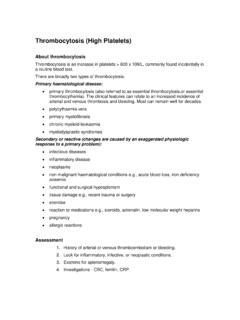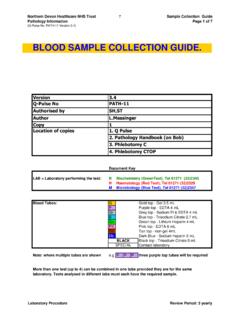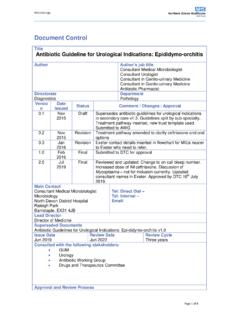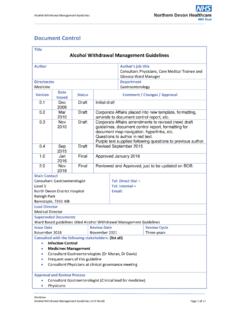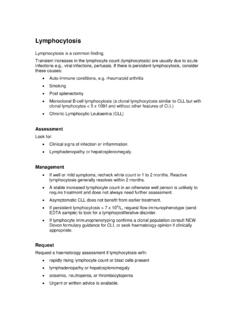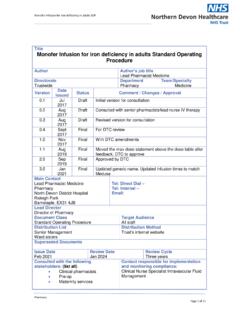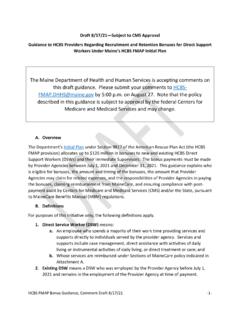Transcription of RECRUITMENT AND RETENTION STRATEGY 2015-2018
1 RECRUITMENT AND RETENTION STRATEGY 2015 -2018 Contents 1. INTRODUCTION .. 4 Strategic Objectives .. 4 Principal Risks .. 4 Why we need a STRATEGY .. 5 Strategic Direction and Context - Intended Outcomes of the STRATEGY .. 5 Key objectives of the STRATEGY .. 6 2. ATTRACTION STRATEGY .. 6 Building a Professional Reputation .. 6 Enhancing RECRUITMENT processes .. 7 RECRUITMENT challenges .. 8 Innovative RECRUITMENT Solutions - Improving the way we advertise .. 8 Targeted RECRUITMENT Campaigns .. 9 Develop the organisation as a socially inclusive employer .. 9 Engaging the Local Community/labour market.. 10 Engaging with Academic Institutions .. 10 Maintaining links with Jobcentre Plus .. 10 National and International RECRUITMENT Markets .. 10 Return to Practice .. 10 HCA Secondment to Nursing/Midwifery Degrees .. 11 Foundation Degrees .. 11 Enhanced Degrees.
2 11 Adaptation .. 11 Physicians Assistants .. 11 3. CORPORATE RETENTION STRATEGY .. 12 Career Pathways .. 13 Flexible Working .. 13 Develop a Flexible Workforce .. 13 Temporary Workforce .. 13 Flexible Careers .. 13 Staff Involvement and Engagement .. 13 Exit Questionnaires .. 14 Developing our current staff .. 14 a Leadership and Talent Management Framework .. 15 Improve working conditions .. 15 Valuing Diversity .. 15 Review the range of Staff non- pay benefits .. 16 Accommodation .. 16 16 Volunteers .. 16 Work Experience .. 16 Strategies for Professional Groups .. 16 4. SUMMARY .. 18 1. INTRODUCTION The NHS is undergoing the most significant period of change that has been seen and remains constantly in the spotlight. RECRUITMENT and RETENTION of good staff remains a challenge ensuring the organisation meets key targets but is nimble enough to meet future agendas for health and social care as articulated in the five year future view.
3 Any STRATEGY for sustaining and innovating the workforce must reflect lessons learnt from national reports or investigations where staffing has been the focus ie Francis Report and Cavendish review. The STRATEGY articulates how we will develop the RECRUITMENT and RETENTION of quality staff who exhibit the key skills, experience, values and beliefs to undertake their job roles effectively, whilst demonstrating their ability to deliver compassionate holistic care. Northern Devon Healthcare NHS Trust (NDHCT) needs to increase substantive staff numbers in some areas in order to ensure establishments meet safer staffing standards to eliminate reliance on the variable workforce and in particular agency staff and improve how it retains, manages and develops its existing workforce. As such it is suggested that a STRATEGY cannot rely on traditional models as it s a time to be bold and innovative with a mandate that supports new ways of working.
4 The demographic realities of an ageing workforce and increasingly attractive career opportunities outside the NHS or the immediate Devon locality, make the RECRUITMENT and RETENTION of staff one of the biggest challenges the NHS faces nationally but further exacerbated by our location and demographics. Due to our integrated models of care and reputation as an employer NDHCT has a unique and vital role to play in providing high quality patient care and improving the health and wellbeing of the local community. We consider that a workforce who represents the local community is pivotal in creating an inclusive environment, in which we can continue to ensure the highest standards and quality of health care provision. The Trust will work in partnership with local organisations such as Job Centre Plus, Schools, The National Apprentice scheme, FE colleges and Universities in developing the skills of the local community and, bringing them into employment locally, we will continue to utilise schemes such as Apprenticeships and widening access models, providing knowledge and qualifications along with work experience.
5 This document sets out the strategic direction in which the Trust will work towards recruiting and retaining the best skilled and dedicated workforce who are signed up to our values. This will be further supported by a detailed action plan and a rewards and recognition STRATEGY to be ratified in October 2015 . Strategic Objectives The Trust s strategic objectives are reviewed by the Board on an annual basis. This paper supports the achievement of the following strategic objectives: X Highest quality X Flexible & multi-skilled workforce X Sustainable services X Efficient & effective X Integrated health & social care X Local provider of choice Principal Risks The Trust s principal risks have been identified through the Trust s risk management processes. They are updated as they are identified by the Risk Management Committee. This paper supports the mitigation of the following principal risks: X Financial planning & management Clinical records management Strategic & business planning X Leadership & management X Workforce numbers Unsafe behaviour X Workforce skills External demands Procedural management X Partnership arrangements Equipment & facilities arrangements Communication Why we need a STRATEGY The shortage of applicants with the right skills, abilities and experience in many professions has created a more competitive market, coupled with a aging workforce and increasing turnover due to retirement.
6 The ability to deliver high quality, compassionate care depends upon recruiting and retaining the right people with the right skills. Therefore, an effective RECRUITMENT and RETENTION STRATEGY that complements the Trusts workforce STRATEGY and Trust objectives and vision is essential. Nationally the percentage of staff who would recommend their organisation to friends and family as a place to work is 62%, whilst the percentage who would not recommend their organisation is 19%. Northern Devon Healthcare Trust was better than average here, with 72% and 12% respectively and identified as one of the top 40 acute providers to work for. Nationally the percentage of staff who would recommend their organisation to friends and family in need of care/treatment is 76%, whilst the percentage who would not recommend their organisation is 8%. Northern Devon Healthcare Trust was again better than average, with 79% and 4% respectively. However, The Trust is at significant risk due to the inability to attract, recruit and retain a high calibre and skilled workforce in areas which are hard to recruit to medical staff, registered nurses and therapists.
7 This RECRUITMENT and RETENTION STRATEGY will aid in informing actions to be implemented to mitigate these risks. Strategic Direction and Context - Intended Outcomes of the STRATEGY This document outlines the strategic direction in respect of the RECRUITMENT and RETENTION initiatives within the Trust over the next three years. It provides guidance on key objectives and in addition provides a summary of the activities that are currently being undertaken in support of that direction as well as highlight how some of these will be further developed over the course of the STRATEGY period. The STRATEGY compliments and should be read in conjunction with other Trust Strategies such as the People, Reward and recognition, and Health and Well Being Strategies as well as the broader NHS Strategies. The intended outcomes of this STRATEGY are as follows: 1. NDHCT will recruit high calibre healthcare professionals to ensure the provision of safe integrated care and high level clinical services within the acute, community and specialist environments.
8 2. NDHCT will manage talent effectively so that it always has the right staff and skill mix to be able to respond speedily and effectively to necessary changes. 3. Staff work effectively in their roles and find their working life with NDHCT to be an enjoyable and rewarding experience. Flexible patterns of work are encouraged and managed in the context of Trust objectives 4. Staff do not leave NDHCT because of failings in relation to their working conditions and the quality of their working experience 5. Staff are loyal to NDHCT, understand and are committed to its aims. 6. High performing staff become the norm for NDHCT through its approach to the RECRUITMENT , development, rewarding and RETENTION of staff 7. Poor performers are equally managed through the Trust supportive policy frameworks such as the Capability Policy to ensure improved performance or that this is appropriately managed. Key objectives of the STRATEGY Reduce the Trusts dependency on bank staff and eleiminate reliance on agency, reducing overall workforce costs as well as ensure the provision of consistent high quality care.
9 Continue to raise the profile of the Trust as the place to work and be treated Ensure a regular and consistent flow of both registered and unregistered healthcare workers to meet vacancy needs as a result of on-going RECRUITMENT based on turnover and service demand. Continue to recruit internationally where relevant and appropriate to complement other UK and more local RECRUITMENT campaigns and initiatives. Maximise cost effectiveness of RECRUITMENT Advertising and use of multimedia platforms. Establish the NDHCT Brand amongst key audiences. Developing Trust E- RECRUITMENT Capacity and Capability In response to LiA Feedback improve the efficiency and dispel perception of the RECRUITMENT process being lengthy and with unnecessary delays. Reduce the time taken to recruit and fill a vacancy. Develop new and innovative new ways of working, re or up-skilling existing workforce whilst flexing our workforce to deliver care in different ways and in different settings.
10 Monitor RECRUITMENT activity and outcomes and produce management information to illustrate such activity in partnership with RECRUITMENT and workforce information teams. Improving overall job satisfaction for our staff through regular opportunities for feedback valuing and developing our staff their working environment. Improving our RETENTION rates. 2. ATTRACTION STRATEGY Building a Professional Reputation In order to enhance our reputationas an Employer of Choice support a positive image within the local community and the wider population, NDHCT must maintain aprofessional, co-ordinated approach to RECRUITMENT and RETENTION we will: Develop an annual RECRUITMENT planner (Gant Chart) which is proactive and has a co- ordinated sustainable flow of candidates within the RECRUITMENT processes linked to the Trust s Workforce Plans focussing on Directorate demand. Improve service standards throughout RECRUITMENT processes by evaluating selected RECRUITMENT campaigns.

